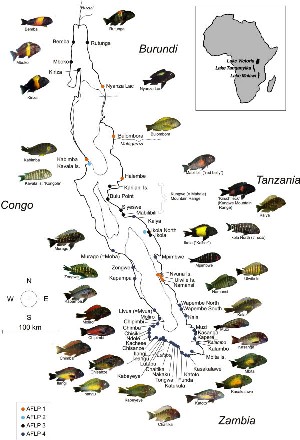
Lake Tanganyika is experiencing unprecedented warming as a result of anthropogenic climate change, researchers say. Sam Shead reports.
Geoscientist Online 14 July 2010
Lake Tanganyika, the world’s second deepest lake, contains nearly four and a half thousand cubic miles of water. Bordered by four African countries (Burundi, DR Congo, Tanzania and Zambia) it is a massive provider of food to local populations. Somewhere between 25 and 40% of the dietary protein of about one million people comes from its fish. A million people are employed by the lake’s fishing industry, which produces 200,000 tonnes of freshwater sardine each year. That vital food source, which has been in decline for some time now, could soon collapse from the effects of global warming, according to US researchers led by Dr Jessica Tierney of Brown University.
Tanganyika’s sardine population relies heavily on high algal productivity in the open-water food web, and on the efficient transfer of carbon from algae to fish. The authors believe that lake waters have not only become warmer, but increasingly stratified over the past 90 years, and that this explains the fall in productivity seen over the period.
Before the researchers began their work, it was unclear whether the observed 20th Century temperatures in Lake Tanganyika were anomalous in the context of the past one and a half millennia. Neither was it known whether there was a link between water temperature and the lake’s declining productivity. Some had argued that data records for the lake were too short to link the trends to global warming.
To resolve this question, the authors reconstructed lake surface temperatures, productivity and regional wildfire frequency over the last 1500 years, using a range of different proxy measures. These included the TEX86 temperature proxy (which relies on the linear relationship between water temperature and the number of cyclopentane rings in the membranes of Crenarchaeota (Archaea) to reconstruct lake surface temperatures); the weight percentage of biogenic silica in sediment, to indicate primary productivity; and the abundance of charcoal in lake cores, to determine aridity. These proxies were obtained from two cores located in sparsely populated areas, to remove as far as possible any influence of human activity.
In a warming climate, one might expect the surface temperature of a deep lake such as Tanganyika to increase more slowly than air temperature. However, stratification of the water slows the transfer of heat to deeper waters. Tanganyika therefore behaves more like a shallow lake, where increases in surface temperatures keep pace with, or even exceed, air temperature. Tierney et al. have found that since 1913, Lake Tanganyika has absorbed heat at about 0.4 watts per square metre – which is approximately twice the rate observed in the global ocean. This they believe reflects stronger climate forcing in the East African region.
This conclusion is serious for the economy of the region because lake surface temperatures and primary productivity seem to be inversely related. Throughout the past 1500 years, rising lake temperatures have led to increased stratification, preventing nutrient recharge from below and therefore limiting organic productivity. The authors also found that temperature changes observed over the past few decades clearly exceed the range of previous natural variability.
This means, say the researchers, that unprecedented changes and corresponding decrease in productivity can only be attributed to anthropogenic global warming, and warn that this could have potentially devastating impacts on fishing and the livelihoods of the millions who depend upon it.
Reference
Jessica E. Tierney et al., 2010 Late-twentieth-century warming in Lake Tanganyika unprecedented since AD 500. Nature Geoscience 3; June 2010 pp 422-425.